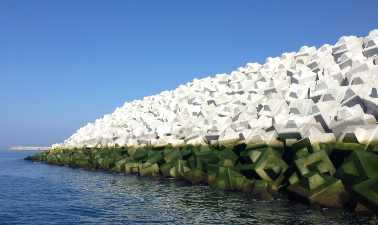Duración
9 weeks
Acerca de este curso
This course is intended for professionals of coastal and port engineering who work in the preliminary design and feasibility studies of breakwaters. The course is planned for civil engineers and other professionals familiar with common coastal and port engineering concepts and terminology.
The goal of this course is to provide the tools to create feasible designs of mound breakwaters protected with Cubipod® armors fulfiling the prescribed economic, functional and safety requirements. Cubipod® is a massive concrete armor unit, the only one which can be safely and easily used in single- and double-layer armoring. This course will be beneficial if you are a civil engineer analyzing variants for breakwaters and feasibility studies.
This course is focused on Cubipod® armored breakwaters, considering the logistic constraints and minimizing the economic cost as well as the carbon and energy footprints. During the feasibility studies, different workable preliminary designs are compared; later, several alternatives are analyzed in detail. This course facilitates the preliminary design of single- and double-layer Cubipod® armored breakwaters.
This course is organized in seven modules corresponding to the seven chapters of the Cubipod® Manual 2016, which will be used as the basic reference book.
Que aprenderé
In this course you will learn: (1) the main characteristics of mound breakwaters and armor layers, (2) the fundamental concepts to be taken into consideration to study alternatives and to estimate costs, with special attention on the use of Cubipods to protect mound breakwaters, (3) the estimation of the hydraulic stability of single- and double-layer Cubipod® armors, run-up, overtopping and forces on crown walls, (4) the assessment of the structural integrity of Cubipods, the manufacturing process, handling, stacking and placement on the armor layer and (5) the rules to make a preliminary design of a Cubipod® armored mound breakwater.
The objective is to learn how to find feasible designs of single- or double-layer Cubipod® armored breakwaters fulfiling the prescribed economic, functional and safety requirements.
Prerrequisitos
General knowledge of Civil Engineering and particular knowledge of Coastal and Port Engineering. Previous knowledge of basic concepts and terminology commonly used in Coastal and Port Engineering is also required, such as “significant wave height”, “peak period”, “crown wall”, “return period”, “stability number”, etc.
Unidades
- Announcement
- Introduction
- Hydraulic stability of the armor layer
- Overtopping and forces on crown wall
- Structural integrity of cubipod® armor units
- Manufacture, handling and stacking of cubipods
- Cubipod® placement in the armor
- Example. Preliminary design of a mound breakwater
- Final exam
Profesores del curso
Josep R. Medina
PhD in Civil Engineering, Josep R. Medina is the Director of the Laboratory of Ports and Coasts at the Universitat Politècnica de València (UPV). Full Professor at the Civil Engineering School of the UPV since 1993, he has served in different academic as well as management positions.
During the last decade, his research activity has focused on physical modelling of breakwaters and product-oriented research, such as the co-invention and development of Cubipod®. More than two hundred papers and several patents describe most of the research work developed in national and international research projects.
M. Esther Gómez-Martín
M. Esther Gómez-Martín holds a PhD in Civil Engineering; her research work began in the Laboratory of Ports and Coasts (UPV) in 2002. She was a Lecturer at the Department of Civil Engineering of the Universidad de Alicante (UA) during eight years (2007-2015), and since 2015, she is a Lecturer at the UPV.
She has participated in several public and private research projects related to physical modelling and design of breakwaters. More than forty papers describe her research work, focusing on mound breakwaters, neural networks and physical modelling. She is co-inventor of the Cubipod® armor unit (Patent ES2264906, US8529153, JP5118031, etc.).


